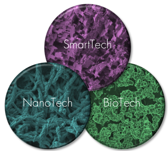Welcome to the
Nature Inspires Creativity Engineers Lab
– University of Nice, France
Our laboratory is internationally known in the synthesis and development of organic and organic-inorganic hybrid materials. Our knowledge allows going from the molecular conception toward the construction of surface with specific properties in different fields: NanoTech, SmartTech, BioTech. |  |
Highlight: A templateless electropolymerization approach for the design of bioinspired coral-like porous nanostructures with special wetting properties combined with fluorescence
O. Sane, A. Diouf, G. M. Cruz, F. Savina, R. Méallet-Renault, S. Amigoni, S. Y. Dieng, F. Guittard, T. Darmanin, Mater. Today, 2019 (https://www.materialstoday.com/biomaterials/comment/a-templateless-electropolymerization-approach)
The design of nanoporous surfaces such as nanotubes with well-controlled dimensions (e.g. diameter, height, porosity) and shape (e.g. cylindrical, spherical) are fundamental in determining the relationship between geometrical parameters of such nanostructures and their ultimate surface properties. The range of potential applications for these nanoporous surfaces is extremely vast. For example, nanotubular surfaces have been employed to encapsulate molecules, materials and even gases. Furthermore, additional applications are currently being explored in fields such as drug delivery and biomedical imaging, and nanocomposites built from these surfaces have potential use in catalysis, electrocatalysis, photocatalysis, batteries, supercapacitors, photovoltaics and sensors. The formation of porous structures such as nanotubes also provides an interesting approach towards controlling and manipulating surface hydrophobicity and water adhesion.
Based on previous results obtained by templateless electropolymerization, in this contribution we wanted to investigate thieno[3,4-b]thiophene derivatives with highly rigid aromatic substituents such as pyrene. We have chosen pyrene as a substituent because it is an excellent electropolymerizable core, known to induce p-stacking interactions and therefore may significantly impact the ultimate surface topography. As an additional merit, pyrene is well-known for its fluorescence properties. With this selection, we have developed optical and multi-scales spatial (nano- and micro-meter ranges) and temporal (nanosecond to several days) studies of new highly structured and luminescent surfaces. Here we focus on the behavior of these structured surfaces upon stimuli (e.g. external perturbations by incubation with bacteria). Engineering new surfaces such as the ones reported here (highly ordered or structured and luminescent) has significant potentials for public health issues such as bacterial infection as well as antibiotic resistance and tolerance. The originality of this project lies in our multidisciplinary approach, which combines innovative chemical and physical methods, green (sustainable) chemistry for the synthesis and in-depth characterization of these surfaces, as well as biochemical and biological methods.

